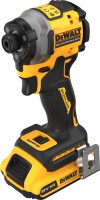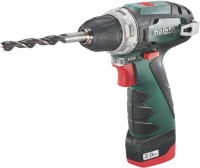Brushless screwdrivers: why are they better than conventional ones

The design and principle of operation of the power tool engine
Let's start with a short digression into the school physics course and recall the principle of operation of the simplest electric motor of a traditional design. The main parts of a classic brushed DC motor are:
- a stator (inductor) is a fixed part in the form of a ring of permanent magnets or a steel cylinder on which the windings of the main and additional poles are located (they act as electromagnets that create a magnetic flux);
- rotor (armature) is a rotating part in the form of a "drum" with a core of ferromagnetic material. Sections of copper winding are laid in its grooves;
- a collector is a cylinder assembled from a set of copper plates isolated from each other, the number of which corresponds to the number of sections on the rotor;
- brushes are small parts made of graphite. They are electrically connected and spring loaded to ensure a constant and tight sliding contact with the manifold.
 |
| Collector motor device. |
When the motor is turned on, current flows through the brushes to the collector, and from there to the armature winding. When current flows through the winding, a magnetic field is generated. Interacting with the constant magnetic field that the stator creates, the rotor rotates due to the fact that like poles repel each other, and unlike poles attract each other. When the collector, which is fixed on the same shaft with the armature, rotates, the brushes “jump” from one contact pad to another. In this case, the direction of the current in the rotor windings changes, opposite poles become the same, they repel each other again - and the rotation continues. Thus, the collector is one of the most important components of the collector (brush) motor, because it performs two important functions at once: it converts direct current into alternating current and at the same time is a shaft rotation sensor.
Engines of this design are relatively simple and cheap. But the commutator-brush assembly is a source of potential problems. Friction between the parts and the constant closing and opening of the plate contacts lead to rapid wear of the brushes, sparking on the contacts and excessive heating of the motor.
The difference between brushless motors and conventional motors
Valve (brushless, brushless) motors operate on the same physical principles, but are arranged differently. They are like an "inside out" version of the collector motors: the magnets are mounted on the rotor, and the winding is on the fixed stator. Thus, you can simply solder the power wires to the winding and get rid of the brushes, along with all their shortcomings.
 |
| Brushless motor device. |
If the collector motor switches the direction of the current mechanically (when the brush “jumps” from one contact plate to the next), then in the valve motor this is done by electronics. Receiving signals from a sensor (optical, magnetic or based on the Hall effect), which "reads" the angle of rotation of the rotor, the electronics switches the poles in a timely manner, changing the direction of the current. That is, the complex of the sensor and the control board performs the functions of a collector, but without mechanical and electrical losses due to the lack of physical contact between the moving and stationary parts of the electric motor.
Benefits of brushless motors theoretically
Knowing how both types of electric motors are arranged, and what is the difference between collector and brushless motors, we can draw conclusions about their advantages and disadvantages.
Brushless motors:
- smaller in size - the absence of a manifold allows you to reduce the length of the engine (with approximately the same diameter) and reduce its weight;
- more reliable - mechanical wear is almost completely absent, and abrasive dust that gets inside the case is not so harmful due to the lack of a collector-brush assembly;
- they heat up less - during operation, much less heat is generated due to a significant reduction in friction losses;
- more energy efficient - electrical switching losses are reduced by several times due to the replacement of the collector and brushes with electronic keys. The efficiency of a brushless motor reaches 80% - 90% (compared to 65% - 75% for a brushed motor);
- they tolerate short overloads better - when working under a heavy load, there is some “margin of safety” that allows for a short time to increase the voltage in the circuit and increase heat dissipation from the windings without harm to the motor.
Benefits of a brushless tool in practice
The theoretical advantages described above give amazing results in practice. Screwdrivers with brushless motors :
- smaller and lighter - the difference in the size and weight of the engines allows manufacturers to produce light and compact devices that are much more convenient to use;
- more powerful and resourceful - replacing mechanical components with electronic control systems allows you to more efficiently use energy and more flexibly control the characteristics of the motor;
- Runs Longer on a Single Charge - Cordless screwdrivers with brushless motors last 30% to 50% longer on battery power than traditional electric motors.
- does not overheat - slight heat generation from the brushless motor allows you to make fewer pauses during operation to cool the tool;
- runs quieter and smoother - friction in the collector-brush assembly inevitably causes noise and increased vibration, and brushless motors are devoid of this flaw;
- does not spark - screwdrivers with brushless motors can be used when working near fuel tanks or oxygen cylinders;
- requires less maintenance - you can completely forget about the problems associated with the selection, purchase and replacement of graphite brushes ;
- less likely to fail - the absence of a friction pair "brush-collector", the ability to endure high loads and resistance to dust significantly increase the reliability of the power tool and significantly increase its service life.
Visually about the difference between brushless motors and conventional ones:
Why are brushless tools so expensive?
So why is a brushless screwdriver so much more expensive than similar devices with traditional motor designs? There are several good reasons for this. The high price is due to the presence of several expensive parts and elements.
- The powerful neodymium magnets needed to create compact brushless motor rotors are quite expensive. They are made according to a complex technological process by sintering expensive rare earth elements.
- The requirements for the quality of sensors are very high. They must be extremely reliable and as accurate as possible in order to turn on and off the current supply in synchronism with the movement of the magnets that are on the rotor, which rotates at great speed.
- Electronics capable of driving a brushless motor are an order of magnitude more expensive than similar brushed motor modules. Roughly speaking, the operation of a brushless screwdriver is controlled not by a primitive board, but almost by a microprocessor that constantly monitors many parameters and changes them on the fly, depending on which task is the highest priority at the moment (maximum power and torque on the shaft, optimal consumption battery energy or overload protection).
The combination of these factors is the reason why brushless tools are so expensive.
But such a complex and high-tech design has a “side effect”. Brushless tools are expensive not only to manufacture, but also to repair. In the event of damage or failure, the main parts of the brushless motor (armature and electronic boards) are replaced only by complete assemblies. Therefore, repairing a brushless tool often costs a pretty penny.
Should I buy a tool with a brushless motor?
In conclusion, we can conclude that the brushless motor is not a marketing ploy, but a real advantage. But the acquisition of a tool with such a motor is not always advisable.
If you're looking to buy a professional-grade cordless tool, you should look into brushless tools. Despite the difference in price, the purchase will be justified, since screwdrivers, grinders, drills, renovators and other equipment equipped with modern brushless motors last longer and do not “kill” expensive batteries so quickly.
But when choosing a hobby-class tool, there is still no point in overpaying for a “newfangled” engine. With occasional use and work at a leisurely pace at home or in the country, the difference in performance between brushless screwdrivers and conventional ones will not be so noticeable.
Articles, reviews, useful tips
All materials



































